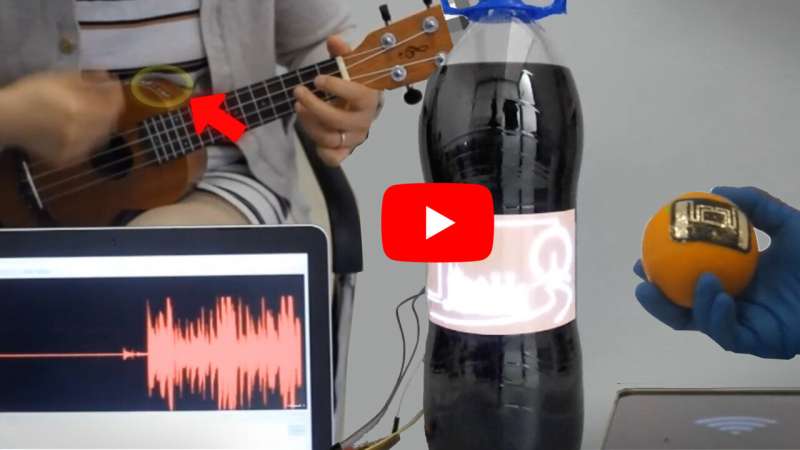Printable liquid metal circuits could someday be used on everything from musical instruments to fruit. Credit: American Chemical Society
Remember iron-on decals? All you had to do was print something out on special paper with a home printer, then transfer it onto a T-shirt using an iron. Now, scientists have developed a very similar scheme, but instead of family photos or logos, it prints circuitry. The method, reported in ACS Applied Materials & Interfaces, can print functional circuits onto items ranging from ukuleles to teacups.
As electronics continue to evolve, so too do the circuit boards that control them. Most boards used today are rigid, built on solid fiberglass backings. As electronic systems are integrated into floppy and pliable items, such as clothing and soft robots, electronics need to be flexible too.
This has led to increased interest in liquid metal circuits, which often include a special alloy of gallium metal that is a liquid at room temperature. One way to make these devices is to print them out with a modified inkjet or 3D printer. But these methods require complicated steps and sophisticated equipment, making the resulting devices expensive and unsuitable for large-scale manufacturing.
To make the fabrication process quicker, easier and cheaper, Xian Huang and colleagues wanted to develop a method of creating liquid metal circuitry using a desktop laser printer that could place the electronics onto many types of surfaces.
To create the circuits, the researchers printed out a connected design onto heat-transferrable thermal paper with an ordinary laser printer. The printer laid down a carbon-based toner, which was transferred to a pane of glass by heating it. These toner patterns roughened the surface and created a hydrophobic gap of air between the carbon and the liquid metal. This prevented the metal from sticking when brushed on top, so the electronic ink-based pattern only adhered on the exposed parts of the surface.
Credit: American Chemical Society
This circuit could then be stuck directly to a smooth surface, such as a plastic soda bottle. If the surface was too uneven, like the bumpy skin of an orange, the device was first placed on a piece of flexible plastic, then onto the rougher surface. Regardless of how they were attached, however, the simple electronics all functioned as intended on their various substrates—from displaying images, to RFID tagging, to sensing temperature and sound. The researchers say that this protocol should greatly expand the applications of liquid metal circuits.
More information: Rui Guo et al, Thermal Transfer-Enabled Rapid Printing of Liquid Metal Circuits on Multiple Substrates, ACS Applied Materials & Interfaces (2022). DOI: 10.1021/acsami.2c08743
Journal information: ACS Applied Materials and Interfaces
Provided by American Chemical Society
























